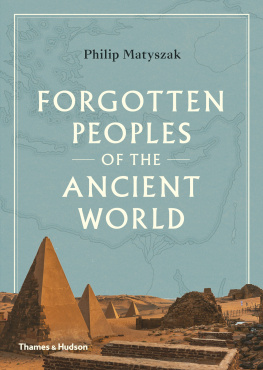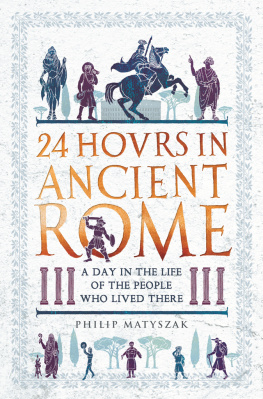To the lady at the top of the tree Barbara Hooley
First published in Great Britain in 2017 by
Michael OMara Books Limited
9 Lion Yard
Tremadoc Road
London SW4 7NQ
Copyright Philip Matyszak 2017
All rights reserved. You may not copy, store, distribute, transmit, reproduce or otherwise make available this publication (or any part of it) in any form, or by any means (electronic, digital, optical, mechanical, photocopying, recording or otherwise), without the prior written permission of the publisher. Any person who does any unauthorized act in relation to this publication may be liable to criminal prosecution and civil claims for damages.
A CIP catalogue record for this book is available from the British Library.
ISBN: 978-1-78243-856-4 in hardback print format
ISBN: 978-1-78243-857-1 in ebook format
Follow us on Twitter @OMaraBooks
www.mombooks.com
C ONTENTS
It is early September in the year AD 137. Romes empire is almost at the height of its power. The imperial eagles have been carried into Mesopotamia and Dacia (and back out again, in the case of Mesopotamia). From the Thames to the Tigris, Rome is mighty, feared and respected.
Most of the people we encounter in this book dont really care about that. For them, life is not about celebrating the glory of empire but about making the rent, coping with difficult relatives and the daily challenges of home and work. Rome might be the greatest city on earth, but those living here still need to navigate the traffic, get on with the neighbours and find good, reasonably priced food in the markets.
This book takes us through one day in the life of Hadrians Rome, with the city seen from the very different perspectives of twenty-four of its inhabitants. We begin at the sixth hour of the night rather confusingly, the Romans started the twenty-four-hour day at midnight, but began counting the hours of the night from the previous sunset. This is just one example of the many ways in which the Romans saw the world differently from how we see it today.
From the viewpoint of the modern reader, many of the people described here live short, squalid lives in an unjust and highly unequal society. Death from infection and illness is omnipresent. Health care and policing are rudimentary, and most social services non-existent. Yet that is not how the people of Rome perceive things. For them, injustice and disease are universal hazards, to be endured and accepted. With all its flaws and inconveniences, Rome is still a better place to live than almost anywhere in the world. Rome has the same disadvantages as everywhere else, but its advantages are incomparable.
Not that the people of this city spend much time wandering about, gawping at their monuments and great civic buildings. They have lives to get on with, and it is into these lives that we take a brief look during this late summer day. Note, though, that our main purpose in doing so is not for what we can discover about the lives of individual people in Rome, but for what they can tell us about Rome itself. Because the Greeks and Romans believe that even should you take away the walls, buildings and roads, you still have a city.
The people are the city: the buildings and monuments later generations of tourists will admire are secondary, important only as the physical echo of the people who built and lived among them. For this reason there are few monuments in this book. The buildings we do encounter are not a set of sterile ruins but one part of a lively, multi-layered and challenging environment.
In the same way, the twenty-four men and women we meet today are not just the inhabitants of Rome they, and hundreds of thousands like them, are Rome. This book is not an attempt to reconstruct the hours of the day for two dozen individual Romans it strives to reconstruct a slice of the life of the city itself, reflected in twenty-four of its many thousands of facets.
While the people in this reconstruction are (largely) fictional, their lives are not. From the point of view of the modern ancient historian, antiquity is less about Great Men than about the social infrastructure that underpinned those men and their deeds. Consequently, archaeologists, sociologists, epigraphists and those in a host of other disciplines have contributed to giving us an overall picture of how ordinary people lived and worked in ancient Rome. This book has drawn upon all these sources, and also upon the most valuable resource of all: the anecdotes, jokes, speeches and correspondence of the people who actually lived there.
The classicist will note where in the cheerful knowledge that the copyright on these works expired centuries ago the writing of a host of contemporary or near-contemporary Romans is woven into the text, from the letters of the erudite Pliny to lewd graffiti salvaged from brothel walls. As far as possible, the people of Rome speak of their experiences for themselves here and, for those Romans who had no voice in their society, this book attempts to speak for them. Often, examples of the original sources are given as excerpts, which accompany the main text, and in many cases the experiences of numerous individuals have been combined to depict one hour in the day of a single person.
The totality of these twenty-four hours is more than the sum of its parts. In the end, this book has only a single protagonist. That protagonist is the city of Rome a teeming, bawdy, barely governable ant-heap of a place. Its flaws are many and sometimes horrifying, yet we nevertheless find in this city a huge energy and optimism.
Theres an entrepreneurial spirit and an unflinching belief that, no matter how good or bad things may be, they can always be made better. In Rome, the slave strives to be free, the freedman to be prosperous, and the wealthy merchant to be accepted by higher society. While often complaining bitterly about their lot, the Romans are seldom resigned to it. They are dynamic, not depressed. They are convinced of their own superiority, and imbued with the feeling that, now they are here at the centre of the universe, they should make the most of it and kick and claw their way to a better life for themselves and their children.
Ancient Rome was more than a collection of buildings. It was even more than a society of interlocked communities of very different peoples and individuals.
Above all, ancient Rome was an attitude.

The fact that Petronius Brevis has a child a daughter gives rise to much ribald humour in the small apartment block that he calls home.
The wife of Petronius Brevis works at a fishmongers stall in Romes Forum Piscarium. As part of her job she has to supervise the transfer of live fish. These fish are brought to Rome at night in barrels of water. They are shipped live to avoid the problem of the fish spoiling during transport from where they were caught. Once extracted from the barrels, during market hours the fish swim around in shallow basins carved into the shops stone counter-tops. That way Romans can get their fish really, really fresh. In fact, it is not unusual for a fish to be served at the table within an hour of its demise at the fishmongers.
Getting the fish out of their barrels and into their counter-top basins needs to be done before the first shoppers hit the forum around sunrise, and this means that the wife of Brevis has to leave home an hour beforehand. Before she sets off for work she usually prepares breakfast and leaves this on the kitchen counter for her husband to eat when he gets in, although, given the hour he will arrive, he might view it as supper.
















